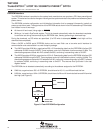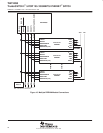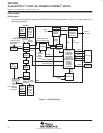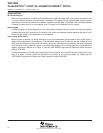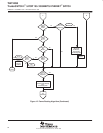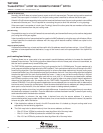
TNETX4090
ThunderSWITCH II
9-PORT 100-/1000-MBIT/S ETHERNET
SWITCH
SPWS044E – DECEMBER 1997 – REVISED AUGUST 1999
49
POST OFFICE BOX 655303 • DALLAS, TEXAS 75265
IEEE Std 802.1Q tags – reception
By the time the IALE examines the received frame, it contains an IEEE Std 802.1Q tag header (after the source
address). The tag used depends on the port configuration. If the port is configured as an access port, IALE
always uses the default VID programmed for this port and assumes that all received frames on this port are
untagged. If the frame already contained a tag, it is tagged again. If the port is programmed as a non-access
port, the tag added depends on the received frame. If the frame is not tagged or the value of the tag field is 0x000,
the default port VID is used to internally tag the frame. Otherwise, the VID contained in the frame is used by
the IALE.
The IALE supports 64 of the possible 4096 VIDs that can be encoded within the IEEE Std 802.1Q tag. The VID
in the received frame is compared with these 64 VLAN IDs to see which (if any) of them it matches.
unknown VLAN
If there is no match, the rest of the address-lookup process is abandoned. A new VLAN interrupt is provided
to the attached CPU. The source address, VLAN ID, and port information is provided in internal registers so that
the CPU can determine if it wants to add this VID to the lookup table. If the destination address is unicast, the
frame is discarded. If the destination address is a multicast/broadcast, the frame is forwarded based on a
programmable port mask.
known VLAN
If there is a match, the VLAN index associated with this VID, together with the destination and source address,
are forwarded to the address lookup and subsequent routing process. (Only one of the VIDs matches if they
have been programmed correctly. If more than one matches, the hardware chooses one of them.)
new VLAN member
The IALE checks to see if the source port already has been declared as a member of this VLAN. If not, an
interrupt is provided to allow the attached CPU to add this port as a new member of the VLAN.
IEEE Std 802.1Q header – transmission
The IEEE Std 802.1Q header is carried within the frame to the transmitting MAC port, where the decision to strip
out the header before transmission is made, based on the port configuration. If the port is configured as an
access port, the tag is stripped before transmission. If the frame is only 64 bytes long, four bytes of pad (0s)
are inserted between the end of the data and the start of the CRC word (a new CRC value is calculated and
inserted in the frame). Three, two, and one byte(s) are inserted for 65-, 66-, and 67-byte frames, respectively.
If the port is configured as a nonaccess port, the VID is compared with the default port VID. If they match, the
header is stripped; otherwise, the header is retained.
If the frame is transmitted to the NM port, no header stripping occurs; the frame is transmitted unaltered. It may
contain one or two IEEE Std 802.1Q headers, depending on how the frame is received.
address maintenance
The addresses within the IALE can be maintained automatically by the TNETX4090, where addresses are
learned/updated from the wire and deleted using one of two aging algorithms looked up during frame-routing
determination. Multicast addresses are not automatically learned or aged. The attached CPU can add/update,
find, or delete address records (see
TNETX4090 Programmer’s Reference Guide
, literature number SPAU003,
for details) via the DIO interface.
The learning and aging processes are completely independent. This allows addresses to be automatically
learned from the wire, but allows the CPU to manage the aging process under software control.
spanning-tree support
Each port provides independent controls to block reception or transmission of frames, learning of addresses,
or disable the port on a per-port basis. Blocking can be overridden to allow reception or transmission of
spanning-tree frames.




